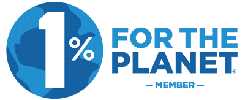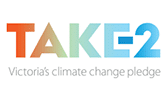One of the key aspects of starting and running a successful business is your business branding. This is particularly important in today’s visual-driven world – your brand needs to stand out to have any chance at being successful!
But it’s important to remember that your business is more than just a memorable logo and catchy tagline. No, your brand is what you convey with everything you put out in the world. It’s the combination of your values and personality and how that helps you connect with your customers.
In this post, we’re diving into a crucial aspect of brand identity – the concept of Brand Archetypes. You can think of these archetypes as a framework of different elements that define your brand and the traits that resonate with your audience on a deeper level.
Keep reading to discover the different brand archetypes and how to build a successful, engaging brand around your archetype.

Understanding brand archetypes
What is a brand archetype?
You can think of a brand archetype as a character with distinctive personality traits representing your business and the type of customers you serve. It’s a great way to inspire your brand with a unique identity or personality, making it more memorable and relatable to your customers.
On a practical level, these archetypes help to determine how your brand looks and communicates with people, ensuring that your business can stand out from the competition in a meaningful way!
Importance of brand archetypes
Identifying and understanding your brand archetype isn’t just a fun, creative exercise. It can be a great way to figure out the best business strategy for your brand and can significantly impact your business growth.
Here are a few benefits of defining your brand archetype:
- Establish a unique brand identity: Your brand archetype will have specific traits specific to your brand identity. In a world full of other small businesses, having a defined set of characteristics and values will help you stand out.
- Connect with your target audience: Different archetypes will resonate with different types of audiences. When you have a deeper understanding of your brand archetype, you can tailor your message to align with the values of your target audience.
- Enhance brand consistency: A well-defined brand archetype will be a guideline or framework for your overall brand experience. From visual identity to your tone of voice, this brand consistency will aid in your brand recognition over time.
- Build brand loyalty: Research has shown that 77% of consumers prefer to buy from companies that share their values. By consistently embodying your brand archetype, you can foster that trust and loyalty among your customer base.
An overview of the 12 brand archetypes
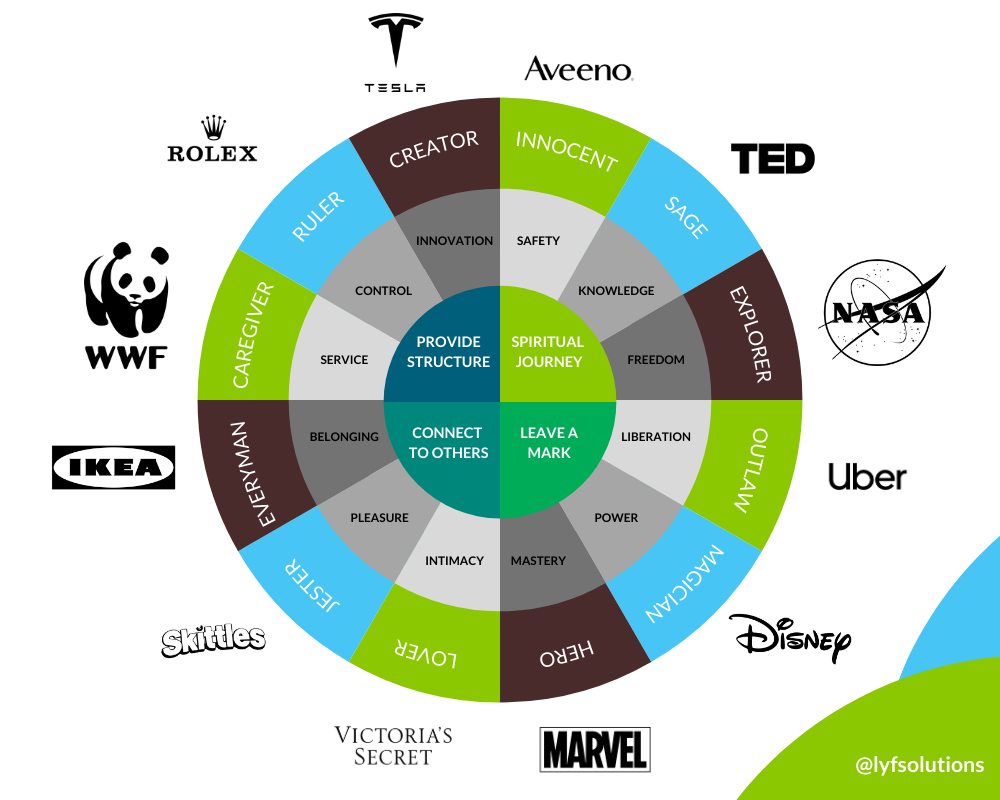
What are the 12 brand archetypes?
Well, we’ll dive a lot deeper into each of them further down, but here’s a quick overview of the 12 brand archetypes and the traits that they embody. Let’s use the Brand Archetype Wheel above as a guide.
Think of the innermost section here as the primary goal of the archetype – the ‘Why’ behind your business. Are you trying to take your customers on a spiritual journey to help them feel more fulfilled? Or maybe the main drive behind your brand is to leave a lasting mark on the world.
Perhaps it’s more accurate to say that your brand’s main goal is to connect with your customers. Or maybe what you provide to your customers is structure.
Moving outwards into the following section, you’ll see words like Safety, Liberation, Belonging, or Innovation. These describe the primary strategy that you use to achieve your goal. This word represents the ‘How’ of your business.
Finally, the last section is your brand archetype – a combination of elements encompassing who you are and what you represent as a brand. We’ve provided an example of a brand that personifies each archetype to make it easier for you to see the key differences between each one.
Let’s say your brand is all about connecting to others – when you narrow it down, is it about providing a sense of Belonging, Pleasure, or Intimacy? If you chose Belonging, your brand archetype is likely ‘The Everyman’.
Now that you have a basic idea of what brand archetypes are all about let’s dive deeper into each one.
Explore the 12 brand archetypes
Now that you’ve got a rough idea of each brand archetype, it’s time to learn more about them!
The Innocent
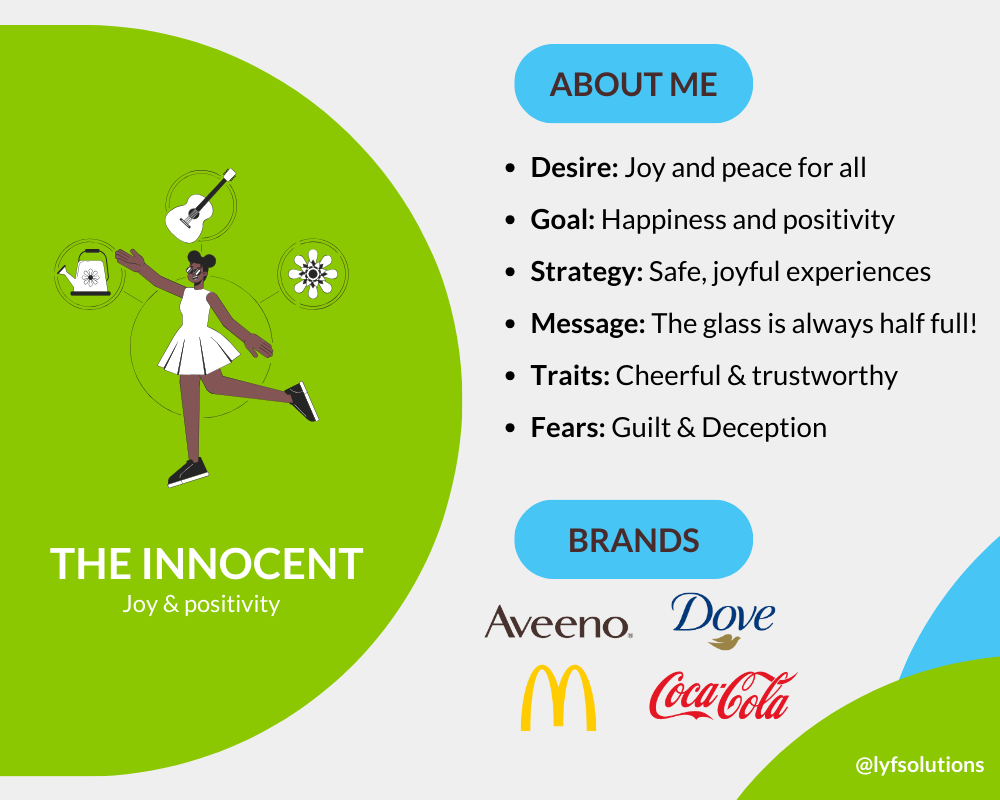
Brands that embody The Innocent archetype tend to display a sense of purity and optimism. These brands are often driven by a desire for joy and simplicity, often seeking to appear trustworthy, cheerful, and wholesome. Brands like Aveeno and McDonalds try to create a positive image that resonates with this world’s goodness, often promoting hope and joy.
- Desire: Joy and peace for all
- Goal: Happiness and positivity
- Strategy: Providing safe, joyful experiences
- Brand message: Optimism – the glass is always half full!
- Traits: Cheerful, trustworthy, honest, loyal
- Fears: Guilt, Fear, Deception, Harm
- Brands: Aveeno, McDonalds, Coca-Cola, Dove
The Sage
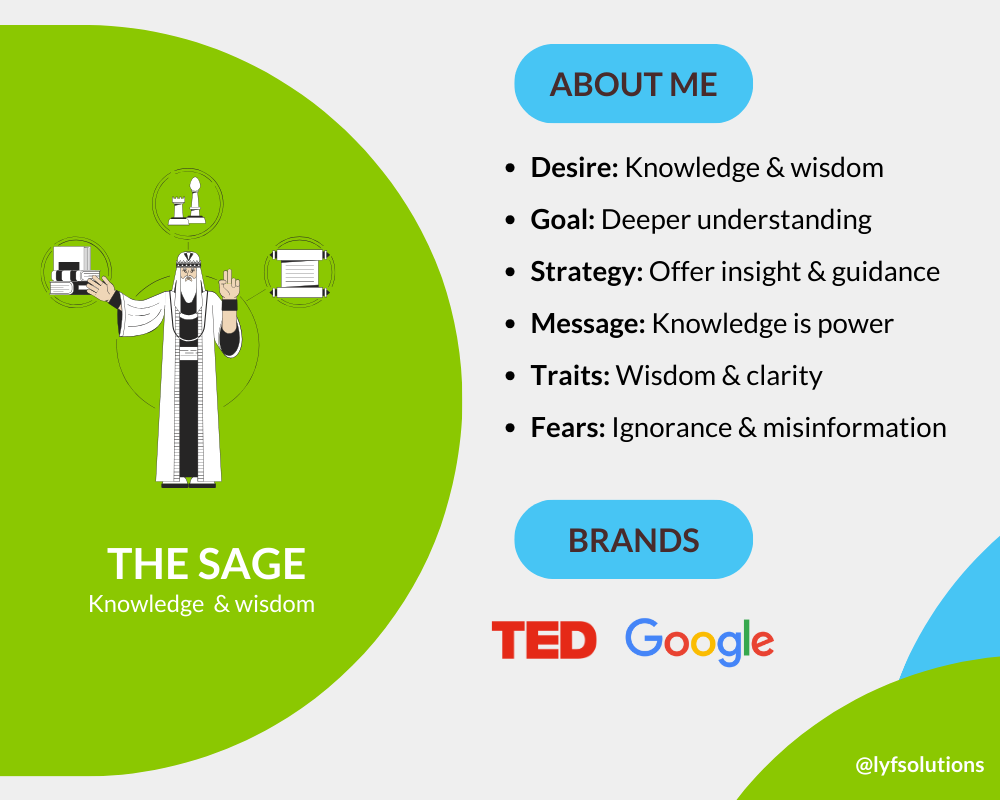
The Sage archetype is driven by wisdom, knowledge, and a desire to understand the world more deeply. Brands that embody The Sage seek truth and clarity, often positioning themselves as a guide for others to understand the world more clearly.
They are characterised by a calm, thoughtful, patient demeanour. Brands that align with this archetype – like TEDTalks and Google – often position themselves as trusted experts, providing valuable insights and guidance.
- Desire: Seek knowledge and wisdom
- Goal: Attain a deeper understanding
- Strategy: Offer valuable insight and guidance
- Brand message: Knowledge is power
- Traits: Wisdom, knowledge, clarity
- Fears: Deception, ignorance, misinformation
- Brands: TEDTalks, Google
The Explorer
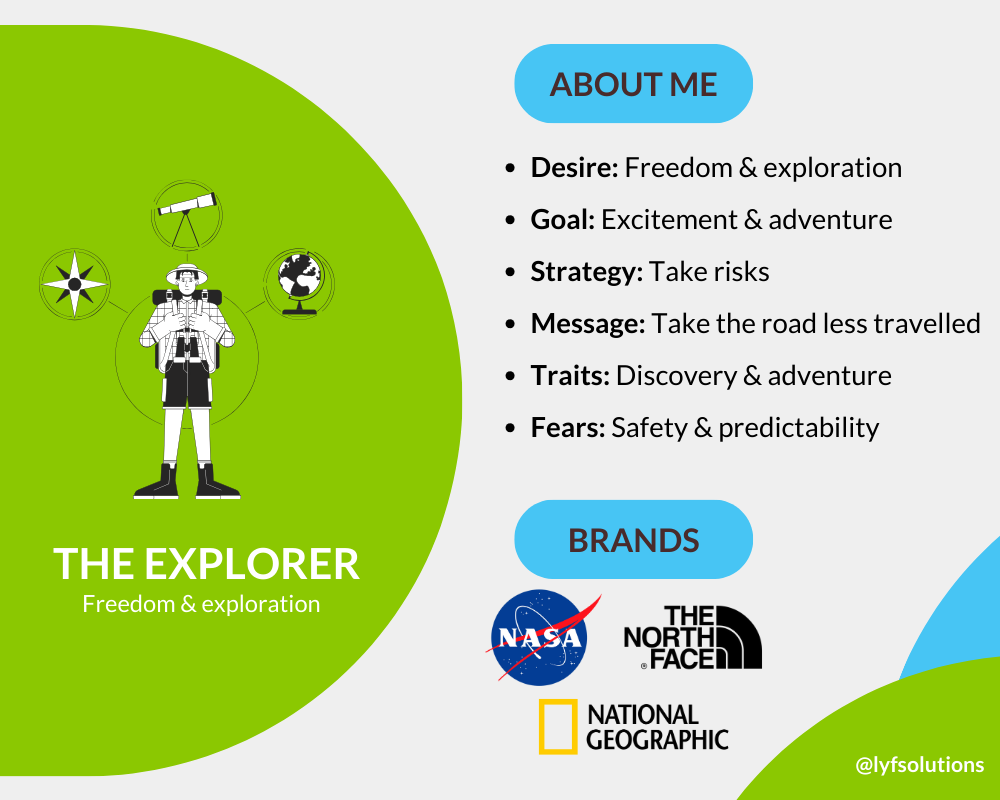
If your brand is driven by the desire for freedom and independence, then The Explorer may well be the brand archetype that you embody the most.
Explorers dislike conformity, preferring to push themselves into uncharted territory where new challenges and goals await. They are adventurous and courageous, on a constant journey of discovery.
- Desire: Freedom and exploration
- Goal: Excitement and adventure
- Strategy: Take risks and approach everything in a unique way
- Brand message: Take the road less travelled
- Traits: Discovery, adventure, and exploration
- Fears: Conformity, safety, predictability
- Brands: NASA, The North Face, National Geographic
The Outlaw
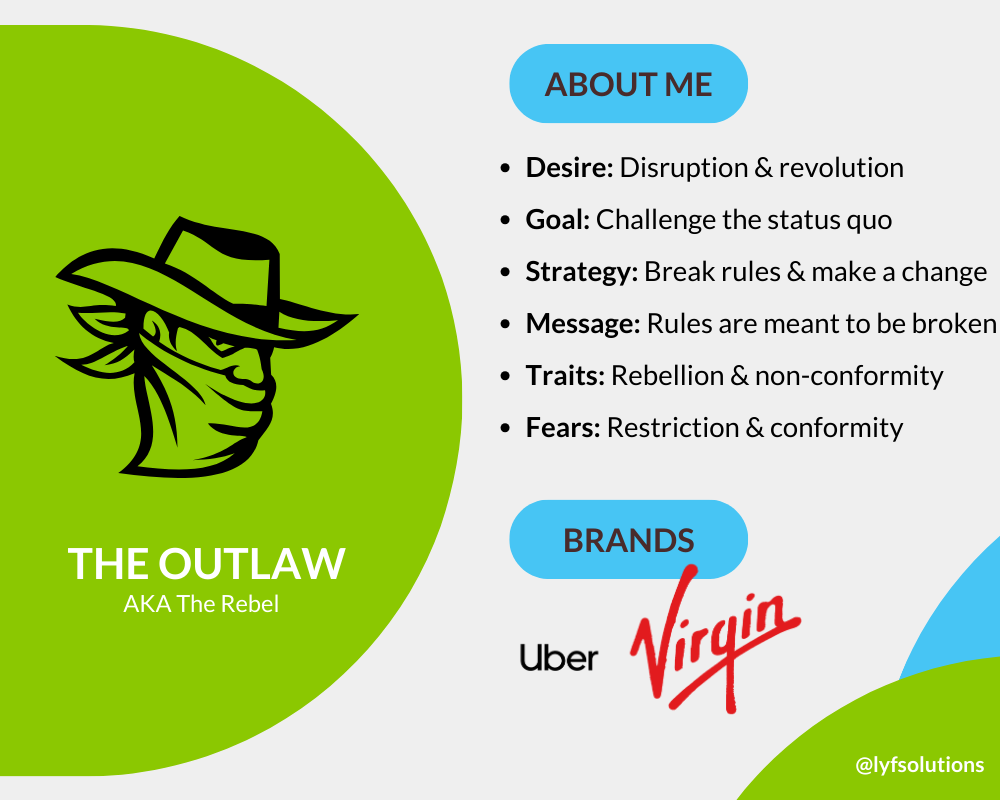
Also known as The Rebel, this brand archetype is defined by their rebellious spirit, often challenging the status quo and pushing against whatever is considered ‘the norm’. Outlaws are often seen as rule-breakers who seek to disrupt established systems, calling for freedom and individuality.
The Outlaw is all about taking risks to create something truly inspiring. Brands that embody the Outlaw archetype often have extremely loyal followers, with fans and customers having a cult-like love for the brand.
- Desire: Disruption and revolution
- Goal: Challenge the status quo
- Strategy: Break the rules to make a lasting change
- Brand message: Rules are meant to be broken!
- Traits: Rebellion, independence, non-conformity
- Fears: Restriction, conformity, being ordinary
- Brands: Uber, Virgin
The Magician
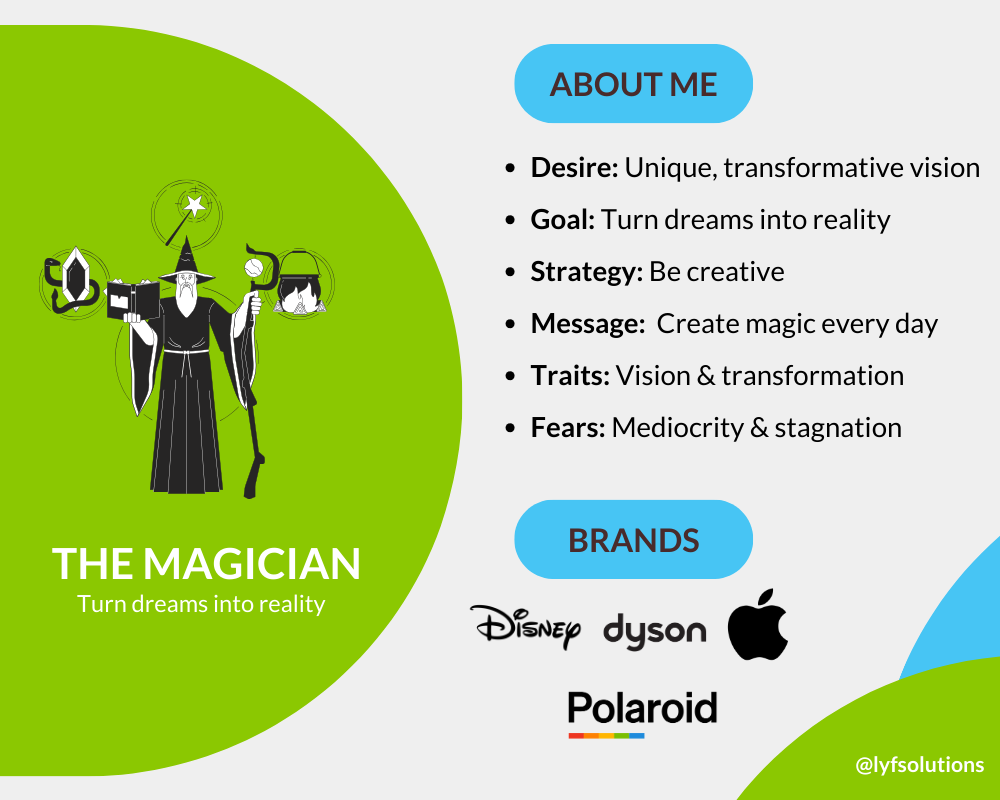
Much like the name would suggest, The Magician is driven by a transformative vision, often using creativity and unique insight to turn dreams into reality.
Brands that embody this archetype are striving to inspire change and bring a profound positive impact on their customers through a deep connection to the mystical. They’re all about turning the ordinary into something extraordinary!
- Desire: A unique, transformative vision
- Goal: Turn dreams into reality
- Strategy: Embrace creativity and positivity
- Brand message: Create magic in everyday moments
- Traits: Vision, transformation, being inspiring
- Fears: Lack of vision, mediocrity, stagnation
- Brands: Disney, Apple, Dyson, Polaroid
The Hero
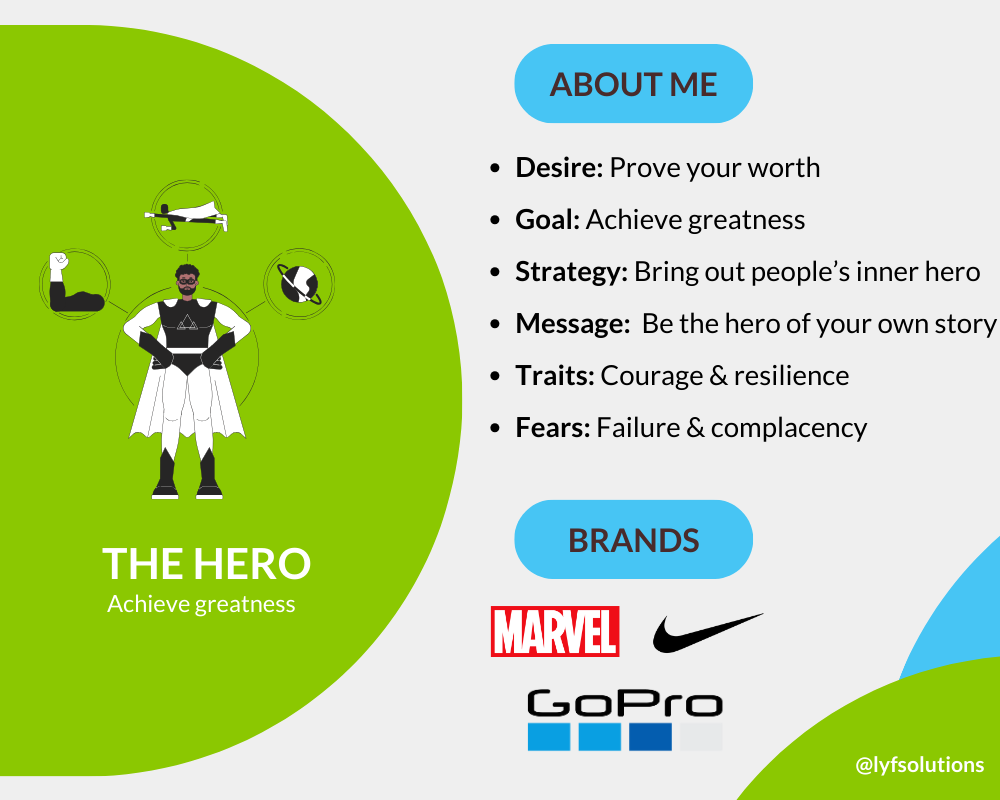
Brands that embody The Hero archetype are driven by a strong desire to overcome challenges and achieve greatness. They aim to inspire others by demonstrating courage, determination, and resilience in the face of adversity.
They offer others a chance to embrace their inner hero and become triumphant in their own personal challenges.
- Desire: Prove your worth
- Goal: Overcome challenges to achieve greatness
- Strategy: Provide tools for others to embrace their inner hero
- Brand message: Everyone can be the hero of their own story
- Traits: Courage, determination, resilience
- Fears: Failure, inaction, complacency
- Brands: Marvel, Nike, GoPro
The Lover
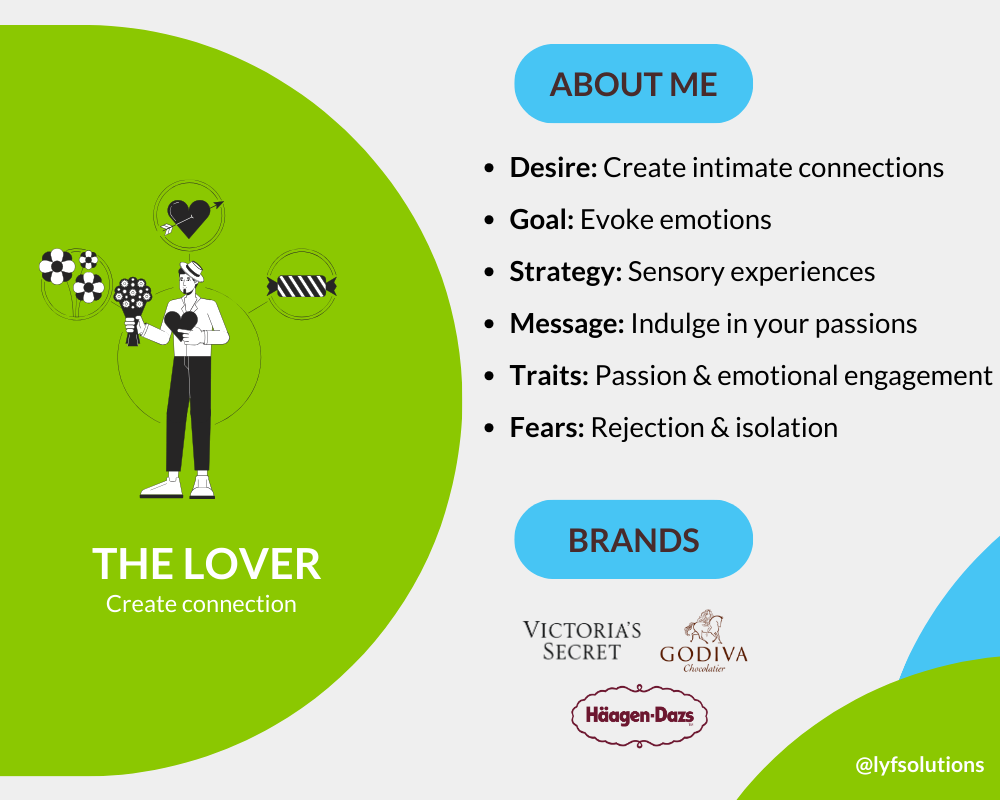
Is your brand driven by a deep desire to create intimate and emotional connections with your audience? Then, this might be the right fit. Brands that embody The Lover brand archetype often strive to evoke emotional responses from their audience – passion, pleasure, and a sense of romance.
They are characterised by a focus on sensory experiences, aesthetics, and emotive language. These brands want to craft experiences that appeal to both the heart and the senses.
- Desire: Create intimate, emotional connections
- Goal: Evoke emotions
- Strategy: Sensory experiences, aesthetics, and emotive language
- Brand message: Indulge in your passions
- Traits: Passion, sensuality, emotional engagement
- Fears: Unpleasantness, rejection, isolation
- Brands: Victoria’s Secret, Godiva, Haagen-Dazs
The Jester
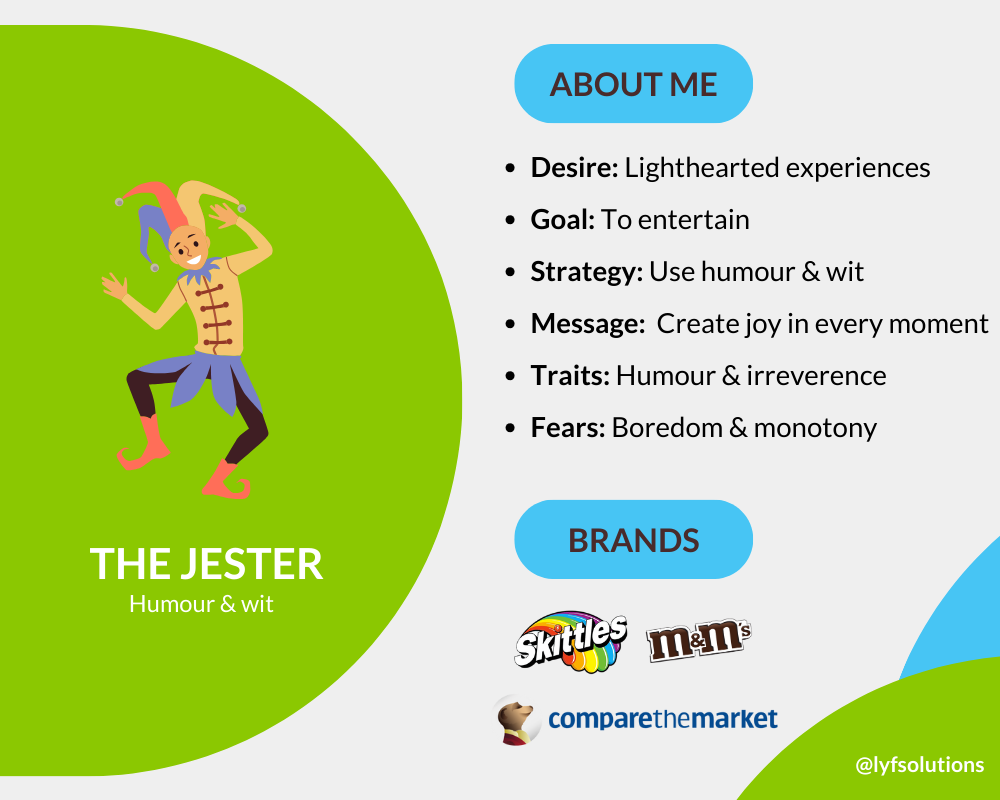
Driven by a joyful, playful, and youthful spirit, this brand archetype often uses humour and wit to entertain its audiences and create a sense of joy.
They are all about spontaneity and irreverence, often finding themselves turning mundane moments into moments of delight. Their messaging often created memorable experiences for their audiences.
- Desire: Creating lighthearted experiences
- Goal: Entertain and create joyful moments
- Strategy: Use humour and wit
- Brand message: Create joy in every moment
- Traits: Humour, playfulness, irreverence
- Fears: Boredom, seriousness, monotony
- Brands: Skittles, M&M’s, CompareTheMarket
The Everyman
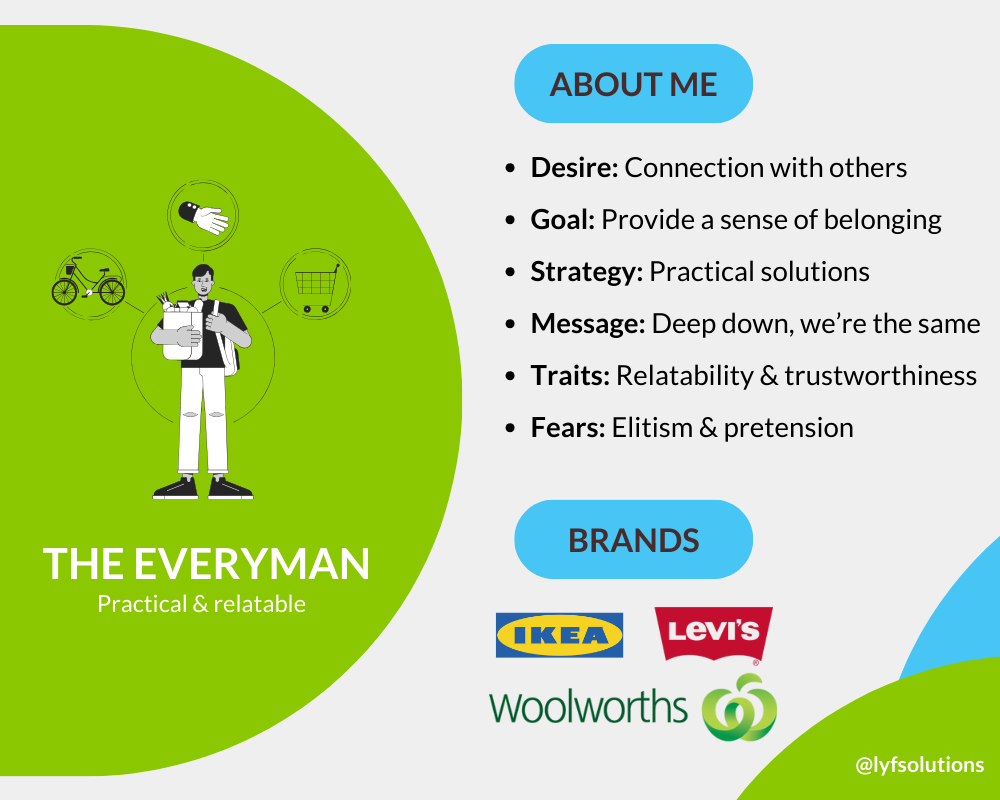
This brand archetype is driven by a need to feel relatable, with a down-to-earth vibe that allows them to spark a deep connection with the masses easily.
The Everyman aims to create products and services that appeal to the common person, often finding mass appeal among the general public. They’re all about keeping it real and relatable, offering solutions to common pain points in our everyday lives.
- Desire: Connection with others
- Goal: Provide a sense of belonging and relatability
- Strategy: Offer practical solutions to relatable problems
- Brand message: Deep down, we’re all the same
- Traits: Relatability, humility, trustworthiness
- Fears: Exclusion, elitism, pretension
- Brands: Ikea, Levi’s, Woolies
The Caregiver
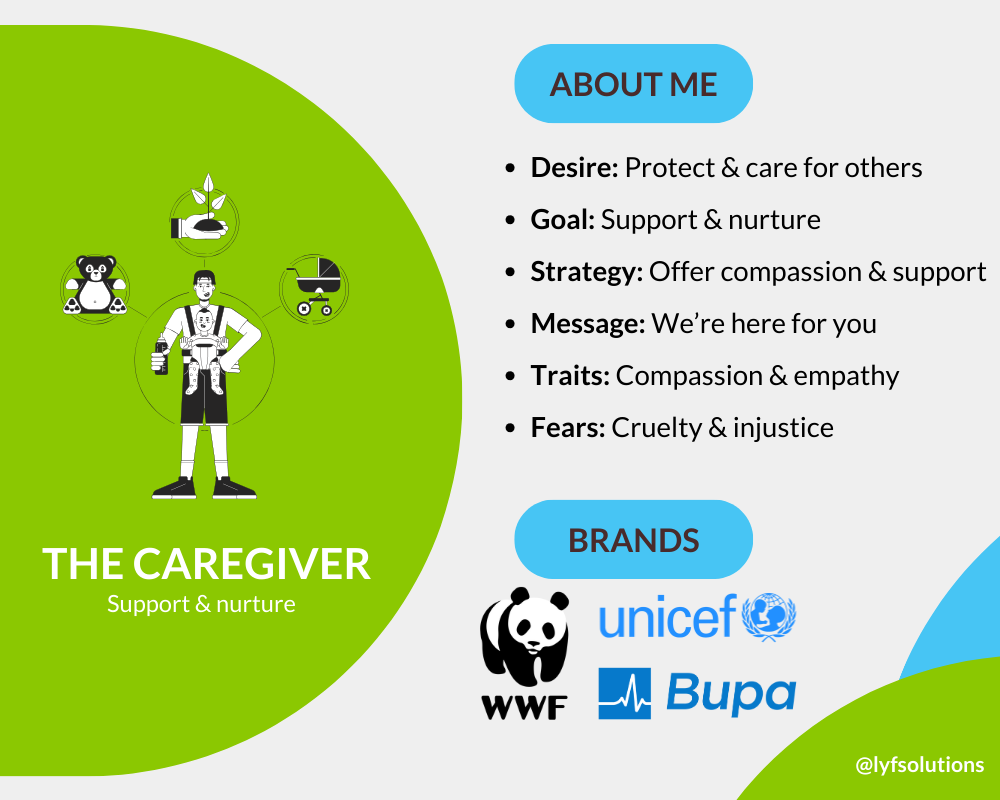
This brand archetype creates a sense of security and well-being for its audience, driven by a desire to protect and care for others. They prioritise compassion, empathy, and generosity and are always ready to lend a helping hand when needed.
They project a caring and supportive image that fosters trust and reliability from their audience and customers.
- Desire: Protect and care for others
- Goal: Support and nurture
- Strategy: Offer compassion and support
- Brand message: We’re here for you
- Traits: Compassion, empathy, generosity
- Fears: Cruelty, injustice, neglect
- Brands: World Wildlife Fund, UNICEF, Bupa
The Ruler
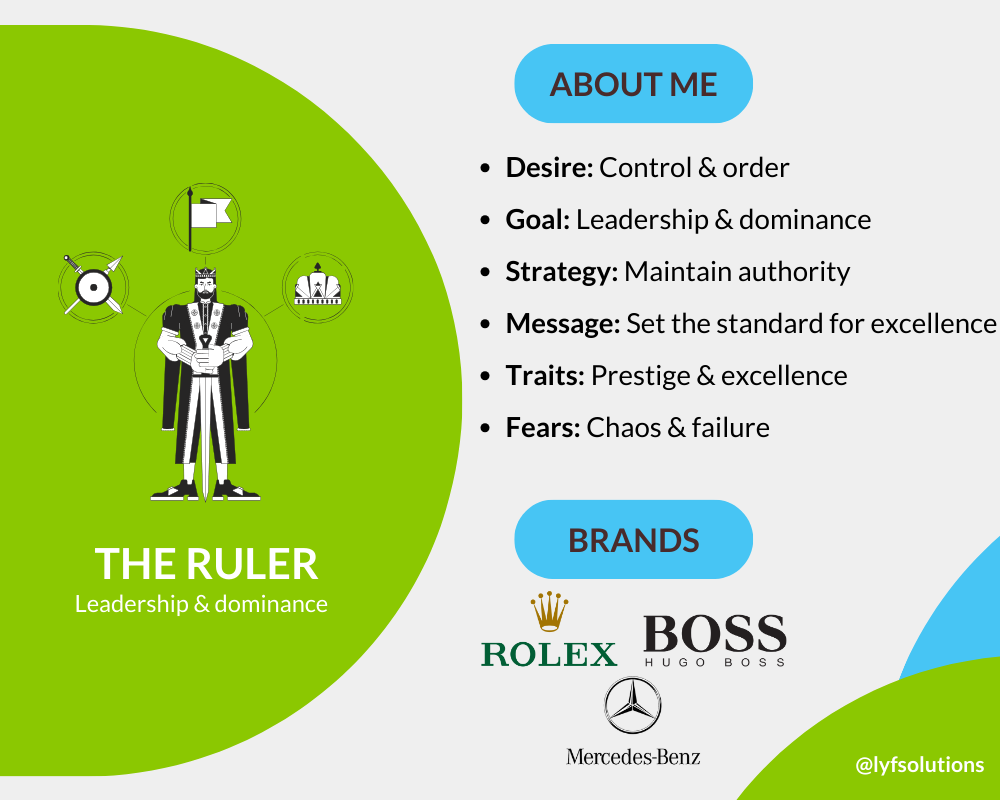
Brands that embody The Ruler archetype are driven by a strong desire for order, control, and leadership. They aim to establish a sense of authority and dominance in their industry, which often means they are characterised by their strategic thinking and decisiveness.
They are committed to maintaining their position of power and projecting an image of prestige and authority.
- Desire: Establish control and order
- Goal: Leadership and dominance
- Strategy: Maintain a position of authority and dominance
- Brand message: Set the standard for excellence
- Traits: Prestige, excellence, control
- Fears: Chaos, failure, lack of control
- Brands: Rolex, Mercedes-Benz, Hugo Boss
The Creator
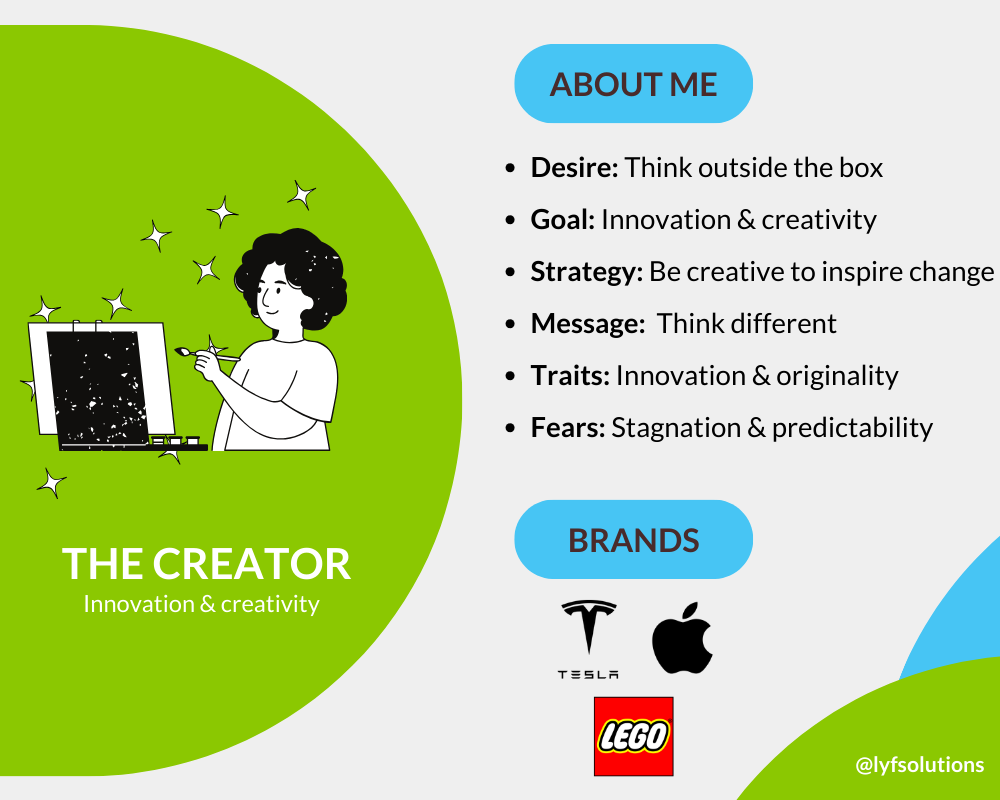
Is your brand defined by its visionary spirit? Then, this brand archetype is the one that you most embody! The Creator brands are driven by a desire to innovate and bring big ideas and experiences to life.
They are often seen as inventors and non-conformists, pushing the boundaries of their industries. Brands embodying this brand archetype aim to empower others to think creatively and embrace their uniqueness.
- Desire: Create a brand that thinks outside the box
- Goal: Innovation and creativity
- Strategy: Use creativity to inspire change
- Brand message: Think different (a classic!)
- Traits: Innovation, originality, creativity
- Fears: Stagnation, predictability, duplication
- Brands: Tesla, LEGO, Apple
Which brand archetype are you?
Now that you better understand each brand archetype, you might want to start figuring out which one applies to your brand.
As we mentioned earlier, defining your brand archetype can help you build a brand strategy, establish a unique brand identity, connect with your target audience, enhance brand consistency, and ultimately nurture brand loyalty.
With this in mind, let’s look at the different ways you can find the answer to that important question: Which brand archetype are you?
1. Self-assessment
The first step in identifying your brand archetype is to spend some time on self-reflection. Use the following list as a guideline to prompt your introspection.
- Archetype exploration – Review the archetype descriptions above and familiarise yourself with their characteristics. Which traits align most closely with your brand identity?
- Define your core values – Take the time to identify the core values that drive your business. What are the main principles that guide all the decisions and actions that you take in your business?
- Understand your mission – Define the purpose of your business – what are the big goals you aim to achieve, and how do they contribute to a broader vision?
- Take the archetype quiz – The Archetype Quiz by Mark and Pearson is a popular online quiz that will provide insights into which brand archetype might be the right fit for your business.
2. Audience analysis
- Define your audience – Identify the demographics and psychographics of your target audience. What are their aspirations, fears, and values?
- Customer feedback – Gather feedback from your existing customers and make sure to ask them what emotions or traits they associate with your brand.
3. Competitor analysis
- Identify your competitors’ archetypes – Take a deeper look at them and try understanding their brand archetypes. Where do their qualities overlap with yours, and where do you differ?
- Analyse your competitors’ audience – When considering your competitors’ archetypes, can you identify which traits resonate with their audience?
4. Storytelling
Craft your brand story – Develop a narrative that describes your brand’s journey and ask yourself these questions:
- What are the challenges that you’ve overcome?
- What triumphs define your story?
- Are there specific traits that come up often in your story that help push the story forward?
5. Team input
- Collaborate with your team – Get everyone involved in a brainstorming session. Ask them to collaborate on a few activities outlined in this list. What archetype do they believe best represents the essence of your brand?
- Use visual mapping tools – Use visual mapping tools like Canva (or simply a big roll of butcher’s paper and a few Textas if you want to go analog) to map out your brand’s characteristics and then use this to align those characteristics with archetype traits visually.
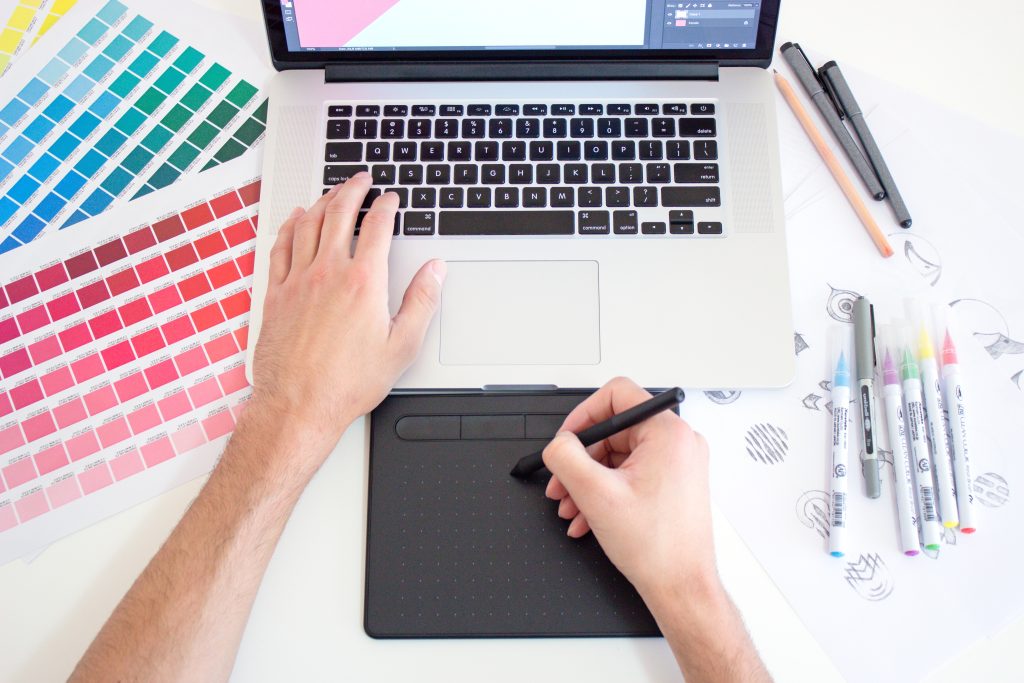
Building a brand with brand archetypes
Now that you better understand branch archetypes and have found the archetype that most accurately represents your brand, it’s time to incorporate your brand archetype into your design and messaging!
Visual elements
- Colour palette: Select colours that reflect your brand archetype. We love colour theory for this. Up to 90% of a person’s assessment of products or services is based on colours, so it’s important to get this right! For example, a brand identifying as the Caregiver archetype would opt for calm tones like blue or green, whereas the Lover archetype would choose sensual hues like red and jewel tones.
- Imagery: Create and/or choose images that truly represent the traits of your brand archetype. Ensure you’re using visuals that align with your brand and can evoke an emotional response from your audience.
- Symbolism: When it comes to logos, take the time to develop one that aligns with your brand archetype. Don’t forget to develop a bespoke brand icon library for your website and other collaterals while you’re at it!
- Typography: Choose fonts that complement your archetype. Think elegant and timeless fonts for the Ruler and simple, minimalist fonts for the Innocent.
- Packaging: If you own a product-based business, design packaging that tells your brand story and expresses your brand archetype. Consider the unboxing experience as well – what details can you include to create a cohesive experience for your customers with your brand archetype? This can play a big role in creating a memorable brand experience!
Brand messaging
- Targeted marketing: Now that you understand your brand archetype and target audience, use this information to tailor your marketing campaigns to appeal to your audience based on their preferences.
- Product/service development: Develop products and services that reflect the traits of your brand archetype and align with your brand identity.
- Web presence: Use brand archetypes to guide your online marketing strategies. This can mean using specific keywords in your SEO or developing a website with colours and images that align with your brand archetype.
- Consistent brand experience: No matter where your customers find themselves in your marketing funnel, ensure that every touchpoint aligns with your brand archetype. This can include everything from your social media presence to customer service interactions.
- Internal branding: Make sure your team is on the same page regarding your brand experience and keep them informed on how your brand archetype influences that experience.
Craft a memorable brand using brand archetypes
Aligning your business with a brand archetype is a brilliant way to aid in the growth of your business. It’s a constant reminder that your brand is more than just a logo and a product or service – it’s a living, breathing entity with its own unique personality.
By choosing a brand archetype and using that to guide your business decisions, you’re inviting your customers on the journey that is your brand story. It’s a compelling narrative that should evoke emotions and trigger connections to ensure your brand stays in their mind for years to come.
If you’ve figured out brand archetypes but still need help putting it all into practice, we can help! Our Web Design & Development team can help you create a website that accurately reflects your brand archetypes, while our Search Engine Optimisation team can help you create content that puts your brand message out into the world.
We can also assist you in your discovery with a 360 workshop, which will virtually include multiple perspectives to get you on the right path. Get in touch with us to learn more!








